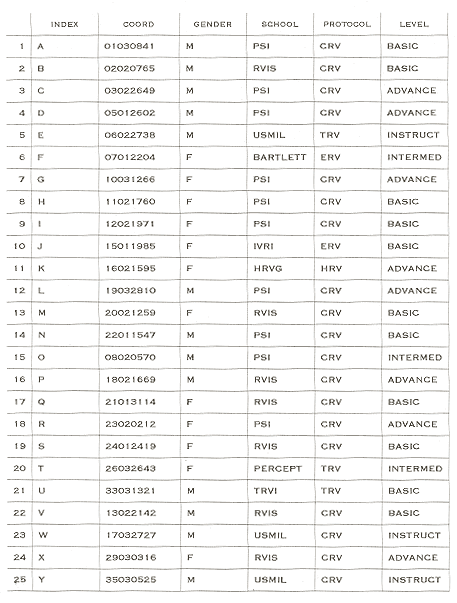2001 REMOTE VIEWING STUDY – Angela Thompson Smith, Ph.D.
Summary and Preliminary Group Data
In 2001 a study was carried out to investigate certain aspects of human consciousness and, in particular, the topic of remote viewing. As part of a much larger study to measure the footprint of consciousness the study investigated characteristics of remote viewing and of the individuals doing the viewing.
In particular, variables such as gender, age, type and length of training, the trait of absorption, and range of handedness were evaluated. Other variables such as distance, time, sidereal time, and presence or absence of solar storms were included, as these might be important to remote viewing performance.
A call went out for trained remote viewers to participate in the study and 25 viewers completed all of the requirements for the study.
The requirements included completion of an Informed Consent, questionnaires, and one remote viewing session.
The study was conducted triple-blind, that is the participants, as well as the experimenter and any monitors, were blind to the targets until they had been scored. Third parties selected the targets and put them into sealed, numbered envelopes, contacted the participants, scheduled the viewing dates, and scored the targets. The target pictures were chosen at random from a pool of 100 targets and provided as feedback to the participants by email and postal mail.
The twenty-five participants who took part in the study;
- Ranged in age from 20 to 66 years.
- There were 13 males and 12 females.
- The participants ranged between 63 and 9,513 miles away from
the picture targets. - The participants had been trained at 8 schools of remote viewing.
Some of the preliminary remote viewing results were interesting.
For example, participants were asked if they used a monitor during their sessions: of the 25 participants, 19 did their session solo.
A scoring method developed by Problems<Solutions<Innovations was used to evaluate the remote viewing sessions. The scale scored each session on 39 categories, on a yes, no, or unknown basis. Trained scorers compared the participants session summaries to the picture target, and a percentage score was given to each session. The summaries ranged from 6% to 100% correct information perceived about the target. The mean correct information obtained by the participants was 63.8%. Ten of the participants perceived 80% and higher correct information.
There was a positive correlation between the time that the participant took to complete their session and their percentage score (p = .037) indicating that shorter sessions appeared to generate higher scores. The participants took on average about an hour to complete their sessions. Higher scores were also positively correlated with level of training (p = .002). However the unequal number of participants from the different training schools made it difficult to estimate any difference between schools. There were no age or gender differences in scores.
The laterality data showed that the participants fell into a distribution of right, left, and mixed- handedness that was comparable to that found in the general population. There was a bias toward being left-eared in the remote viewing group, compared to a right-ear preference in the general population. The study population was equally divided between having a right or left-eye preference. In the general population, being right-eyed is the norm. Also the study participants were equally divided between being right or left-footed where the norm in the general population is to be right-footed.
Variables such as the trait of absorption, distance, time, sidereal time, and presence or absence of solar storms were not compared to session scores, at this time, because of the small database. There was insufficient data for these measures to give a meaningful analysis.
Further data will be collected in the future to evaluate these measures.
I would like to thank all of the research participants and volunteers who contributed their time and expertise in order to carry out this study. The full study will eventually be written up for publication. Funding is being sought to replicate and extend this study in the future.
(Below) A list of the remote viewing participants, gender, RV school, protocol and level of experience.

Download or view Remote viewing sessions A – C (adobe pdf file)
Download or view Remote viewing sessions D – F (adobe pdf file)
Download or view Remote viewing sessions G – I (adobe pdf file)
Download or view Remote viewing sessions J – L (adobe pdf file)
Download or view Remote viewing sessions M – O (adobe pdf file)
Download or view Remote viewing sessions P – R (adobe pdf file)
Download or view Remote viewing sessions S – U (adobe pdf file)
Download or view Remote viewing sessions V – Z (adobe pdf file)
